Neuroprosthetics Market Size
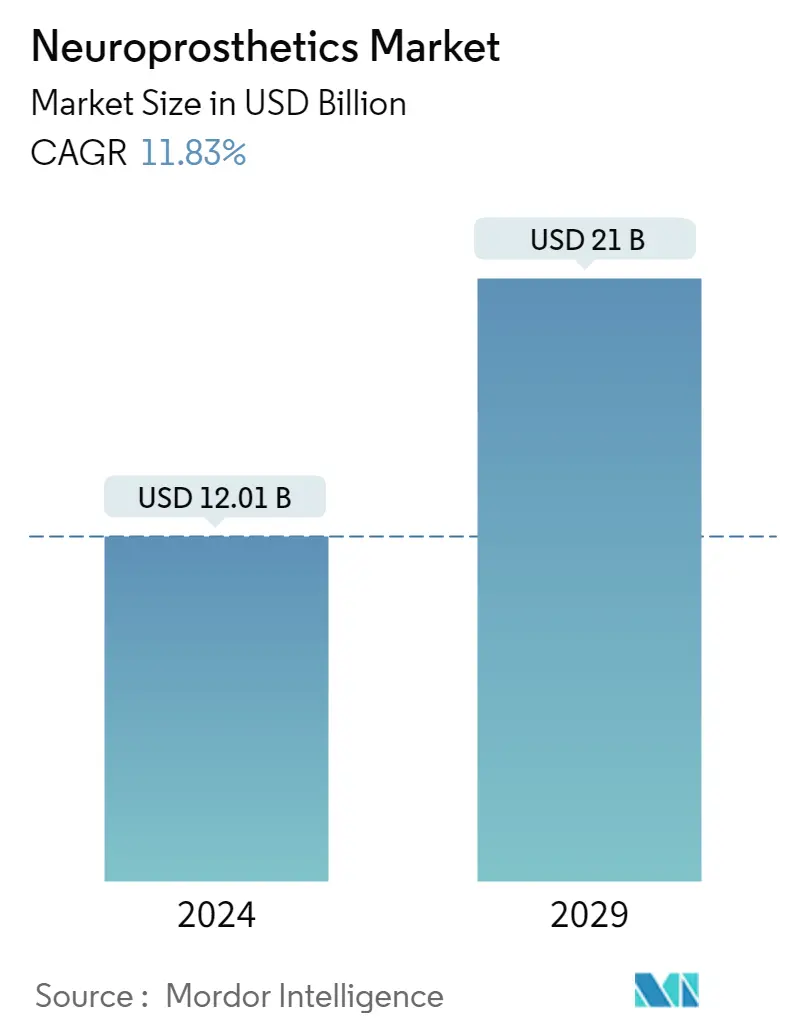
| Study Period | 2019 - 2029 |
| Market Size (2024) | USD 12.01 Billion |
| Market Size (2029) | USD 21.00 Billion |
| CAGR (2024 - 2029) | 11.83 % |
| Fastest Growing Market | Asia Pacific |
| Largest Market | North America |
Major Players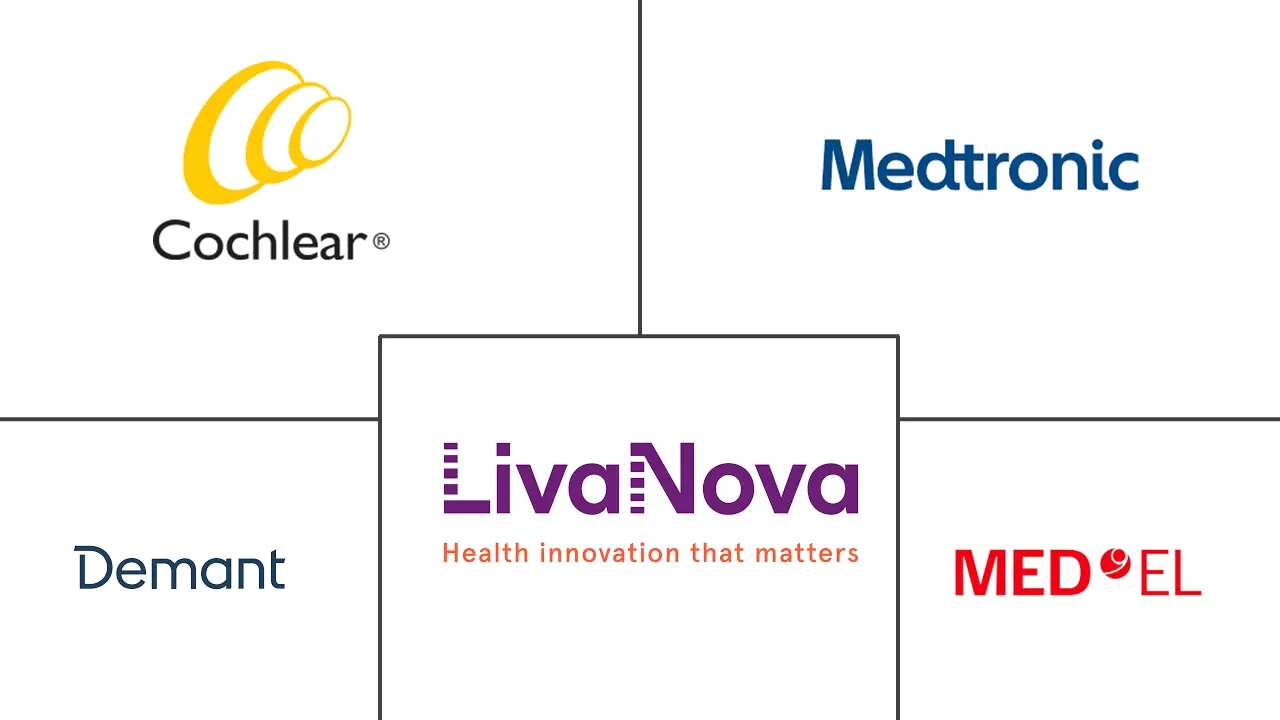
*Disclaimer: Major Players sorted in no particular order |
Neuroprosthetics Market Analysis
The Neuroprosthetics Market size is estimated at USD 12.01 billion in 2024, and is expected to reach USD 21 billion by 2029, growing at a CAGR of 11.83% during the forecast period (2024-2029).
The neuroprosthetics market was significantly impacted by the outbreak of the COVID-19 pandemic initially. According to an article published by PubMed Central in January 2021, hearing loss was said to be a relatively newly reported symptom of COVID-19, and the study further showed that two cochlear-implanted children showed symptoms of a sudden speech perception problem after being infected with COVID-19. Thus, owing to the aforementioned factors, the pandemic had a considerable impact on the studied market initially. However, currently, as the pandemic has subsided that market has gained traction and it is expected to have stable growth during the forecast period of the study.
Factors such as the increasing number of patients suffering from neurological disorders and nerve injury and the growing burden of hearing loss and related defects are expected to enhance the growth of the market.
People with hearing loss benefit from early identification as it enables the use of hearing aids, cochlear implants, and other devices. According to the World Health Organization, in 2021, approximately 2.5 billion population globally are estimated to experience hearing loss by 2050, and nearly 700 million are estimated to require hearing rehabilitation by 2050. Thus, the high burden of hearing loss among the global population is one of the major drivers for the growth of the neuroprosthetics market. The cochlear implant is one of the key neuroprosthetic devices that had provided immense benefits for people with deafness or severely hard-of-hearing. This device can also be used by patients who have experienced intense hearing loss caused by disease or injury, allowing them to hear sounds in their environment. Hence, with the increasing incidences of hearing loss, scientists are investing more in novel neuroprosthetics, which will drive the market over the forecast period.
According to the data by WHO in February 2022, epilepsy is a chronic noncommunicable neurological disease of the brain that affects people of all ages, and around 50 million people worldwide have epilepsy, making it one of the most common neurological diseases globally. It is estimated that nearly 80% of people with epilepsy live in low- and middle-income countries. The increasing prevalence of neurological diseases like epilepsy is also expected to enhance the market growth.
Furthermore, key developments in the market is also a major factor driving the growth of the market. For instance, in April 2021, Houston Methodist and Rice U. collaborated to develop translational neural prosthetics and interfaces to focus on restoring brain function after disease or injury. Thus, in view of the developments regarding neuroprosthetics, the neuroprosthetics market is expected to register healthy growth in the coming years.
Therefore, owing to the aforementioned factors such as the increasing number of patients suffering from neurological disorders and nerve injury, the growing burden of hearing loss and related defects, and the key developments in the market, the studied market is anticipated to witness growth over the analysis period. However, the availability of alternative treatment options and the high cost of neuroprosthetics are likely to impede the market's growth.
Neuroprosthetics Market Trends
This section covers the major market trends shaping the Neuroprosthetics Market according to our research experts:
The Input Neural Prosthetics Segment is Expected to Show a Significant Growth Over the Forecast Period
The input neural prosthetics segment is expected to show better growth over the forecast period owing to the growing burden of hearing loss and advancements in technology for the development of novel devices. The input neural prosthetics include a cochlear Implant, bionic eye/retinal Implant, and others. These are electronic devices that can help to provide a sense of sound to a person who is profoundly deaf or severely hard of hearing. The implant consists of an external portion that sits behind the ear and a second portion that is surgically placed under the skin.
The advantages offered by cochlear implants and their increasing usage are expected to drive segment growth. According to the research article published by frontiers in July 2022, a cochlear implant (CI) overall provides a very good outcome in hearing loss, and elderly patients with hearing impairments benefit from a cochlear implant in terms of speech comprehension if there is a large cochlear coverage and the therapy is not hampered by comorbidities, especially cognitive decline. Hence, the increasing advantages offered by cochlear implants are expected to drive segment growth over the forecast period.
Moreover, the increasing number of neurological disorders is also expected to enhance the adoption of input neural prosthetics. For instance, according to the data published by The European Academy of Neurology in May 2022, around 1 in 3 people are affected by a neurological disease at some point in their life.
Furthermore, the market for these prosthetics is expected to show better growth due to the higher number of children born with hearing defects, and the increasing awareness, along with growing research, in the field of neuroprosthetics. Additionally, the growing incidence of neurological disorders such as Alzheimer's Disease, traumatic brain injury, and Parkinson's Disease, and the rising geriatric population are also expected to boost the segment growth. For instance, according to an article published by the National Medical Journal of India in January 2022, low-income countries such as India are particularly susceptible to hearing loss due to the lack of availability of screening programs for newborns, high prevalence of chronic ear infections in the young, and the lack of resources for the elderly. Thus, the high prevalence of hearing loss in newborns, adults, and the elderly is expected to enhance the adoption of input neural prosthetics.
Therefore, the input neural prosthetics segment is expected to witness significant growth over the forecast period due to the abovementioned factors such as advantages offered by cochlear implants and their increasing usage, the high prevalence of hearing loss in newborns, adults, and the elderly, and increasing number of neurological disorders.
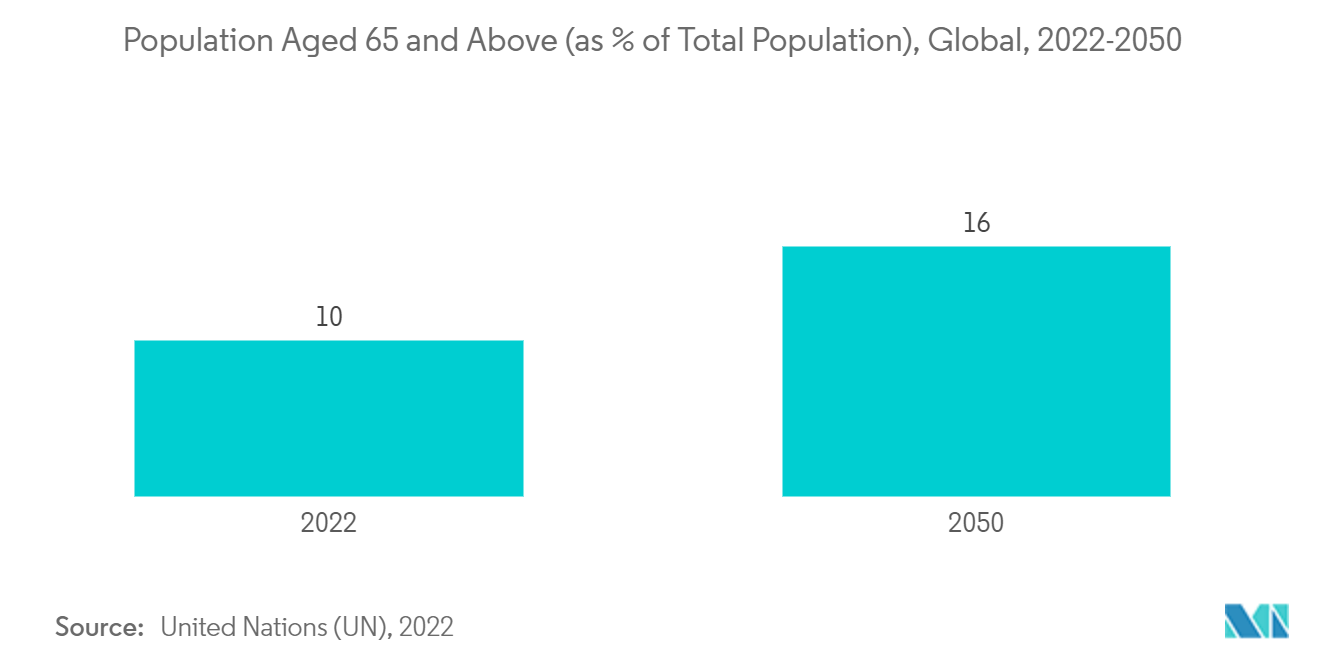
North America is Estimated to Hold a Significant Share in the Neuroprosthetics Market Over the Forecast Period
The neuroprosthetics market is estimated to hold a significant share in the North American region due to the increasing number of patients suffering from neurological disorders and nerve injury. Additionally, the number of cases where children are born with hearing defects is increasing.
Furthermore, the National Institute on Deafness and Other Communication Disorders 2021 stated that approximately one in three people in the United States between the ages of 65 and 74 have hearing loss, and nearly half of those older than 75 have difficulty hearing. Age is the strongest predictor of hearing loss among adults, with 91% of adults with hearing loss aged 50 and older. Therefore, the increasing geriatric population and the growing burden of hearing loss in the region are expected to boost the market for neuroprosthetics. Also, the high concentration of global players and the research activities, with the increasing trend of product approvals in the North American region, is anticipated to play a vital role in the growth of the studied market. Hence, with the rising acceptance of neuroprosthetic technology, the market is expected to grow in the forecast period.
Moreover, according to the data by the Government of Canada in March 2022, approximately three in five adults in Canada have hearing loss (23%), tinnitus (22%), or both conditions (14%).
Furthermore, according to the data published by the Alzheimer's Association in 2022, an estimated 6.5 million Americans aged 65 and older are living with Alzheimer's disease in 2022 out of which 73% are aged 75 or older. It was also stated that in 2022 Alzheimer's and other dementias will cost the United States USD 321 billion and by 2050, these costs could reach nearly USD 1 trillion. Hence, the increasing prevalence of neurological diseases like Alzheimer's are also expected to boost the market growth.
Therefore, owing to the aforesaid factors such as the increasing prevalence of neurological diseases like Alzheimer's and the increasing geriatric population and the growing burden of hearing loss in the region, the growth of the studied market is anticipated in the North American region.
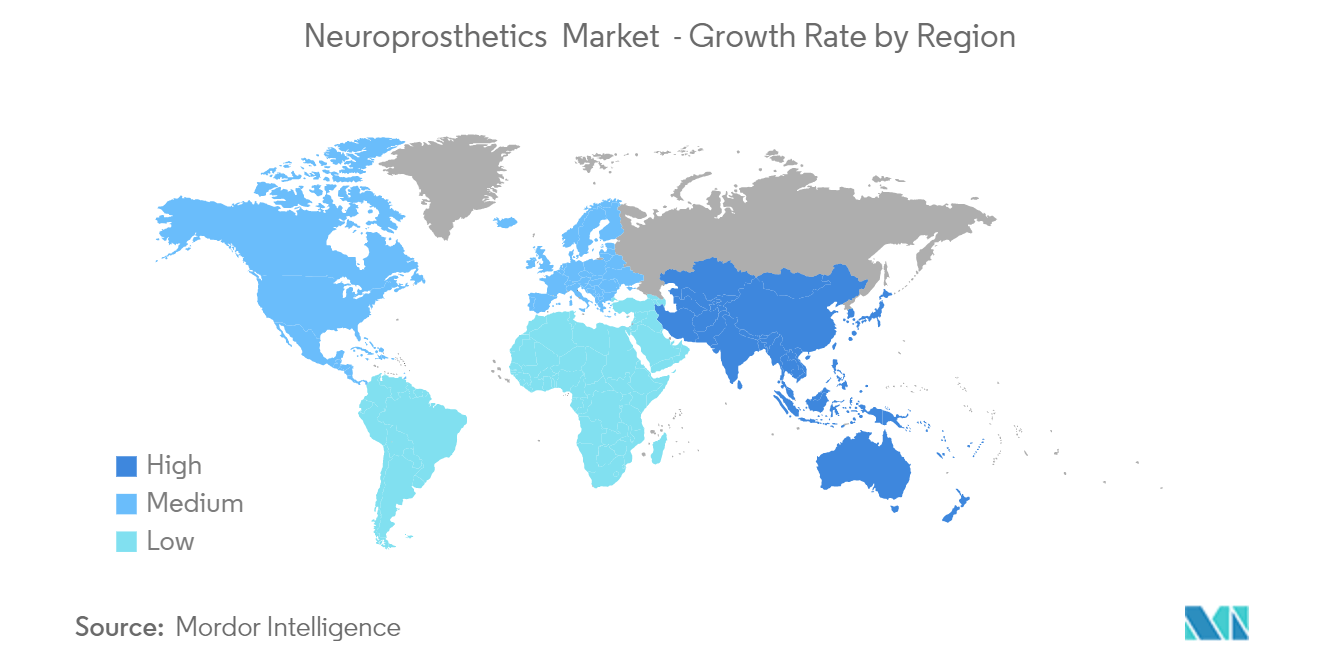
Neuroprosthetics Industry Overview
The neuroprosthetics market is moderately competitive, with market players present both globally and regionally. The global players in the neuroprosthetics market are Abbott Laboratories, Boston Scientific Corporation, Cochlear Limited, Demant AS, LivaNova PLC, MED-EL, Medtronic PLC, and Sonova Holding AG.
Neuroprosthetics Market Leaders
-
Medtronic PLC
-
LivaNova PLC
-
Demant A/S
-
MED-EL
-
Cochlear Limited
*Disclaimer: Major Players sorted in no particular order
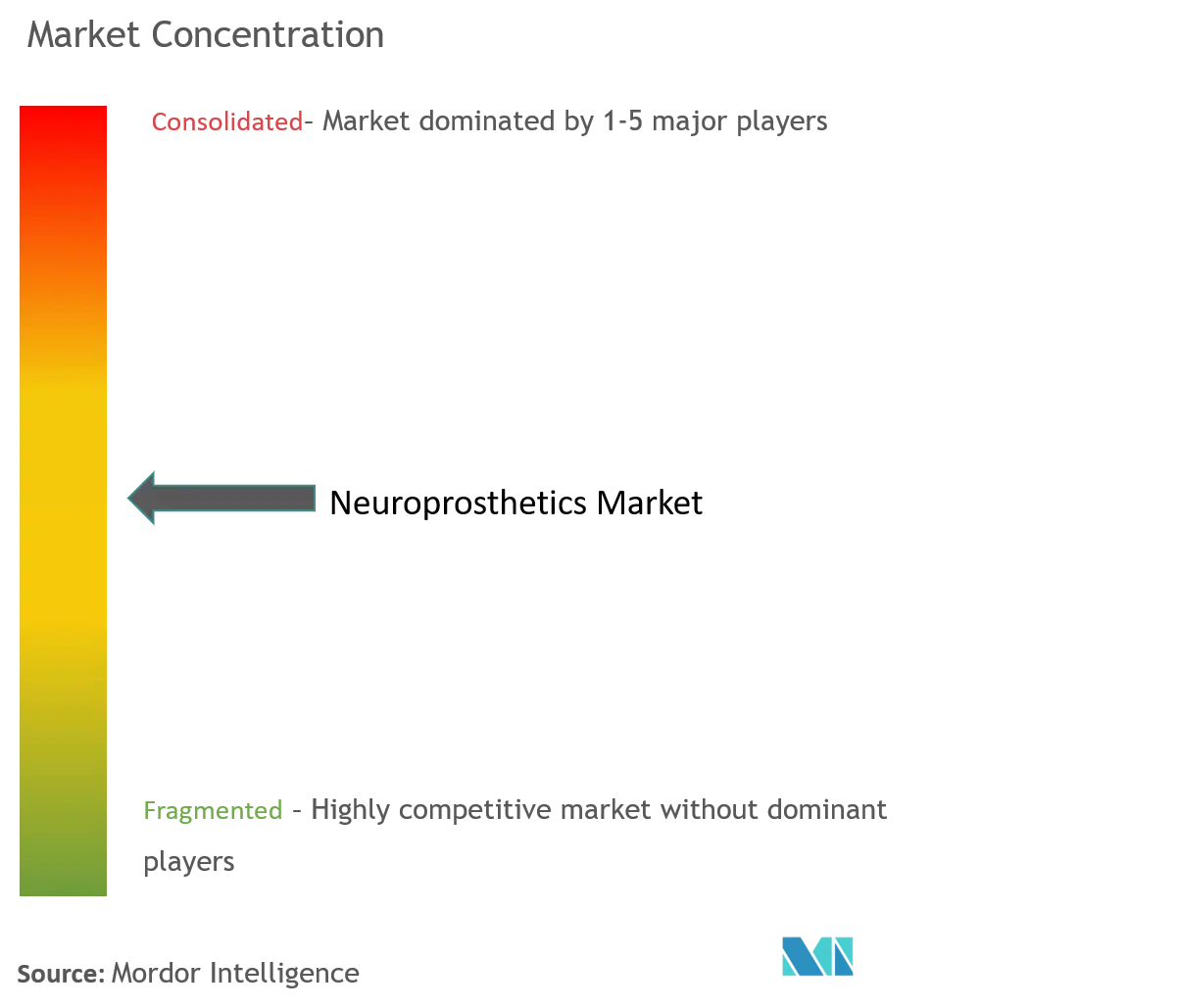
Neuroprosthetics Market News
- In December 2022, the Government of Saskatchewan through the Ministry of Health and the Saskatchewan Health Authority (SHA), implemented the expanded Cochlear Implant Program to help those who need their external sound processor replaced. Under the new program, individuals will co-pay USD 840 per implant with the Ministry of Health covering the remainder of the cost, which is often USD 8,000 to USD 12,000.
- In October 2022, Axoft, a neurotechnology company, launched its brain-machine interface (BMI) to better treat neurological disorders, it was launched through FDA breakthrough device designation. The company secured USD 8 million in capital to fund pre-clinical studies with the FDA and to scale up prototypes of its neural implants.
Neuroprosthetics Market Report - Table of Contents
1. INTRODUCTION
- 1.1 Study Assumptions and Market Definition
- 1.2 Scope of the Study
2. RESEARCH METHODOLOGY
3. EXECUTIVE SUMMARY
4. MARKET DYNAMICS
- 4.1 Market Overview
-
4.2 Market Drivers
- 4.2.1 Increasing Number of Patients Suffering from Neurological Disorders and Nerve Injury
- 4.2.2 Growing Burden of Hearing Loss and Related Defects
-
4.3 Market Restraints
- 4.3.1 Availability of Alternative Treatment Options
- 4.3.2 High Cost of Neuroprosthetics
-
4.4 Porter's Five Forces Analysis
- 4.4.1 Threat of New Entrants
- 4.4.2 Bargaining Power of Buyers/Consumers
- 4.4.3 Bargaining Power of Suppliers
- 4.4.4 Threat of Substitute Products
- 4.4.5 Intensity of Competitive Rivalry
5. MARKET SEGMENTATION (Market Size by Value - USD million)
-
5.1 By Type
- 5.1.1 Output Neural Prosthetics
- 5.1.2 Input Neural Prosthetics
-
5.2 By Technique
- 5.2.1 Spinal Cord Stimulation
- 5.2.2 Deep Brain Stimulation
- 5.2.3 Vagus Nerve Stimulation
- 5.2.4 Other Techniques
-
5.3 By Application
- 5.3.1 Parkinson's Disease
- 5.3.2 Alzheimer's Disease
- 5.3.3 Epilepsy
- 5.3.4 Auditory Processing Disorders
- 5.3.5 Ophthalmic Disorders
- 5.3.6 Other Applications
-
5.4 Geography
- 5.4.1 North America
- 5.4.1.1 United States
- 5.4.1.2 Canada
- 5.4.1.3 Mexico
- 5.4.2 Europe
- 5.4.2.1 Germany
- 5.4.2.2 United Kingdom
- 5.4.2.3 France
- 5.4.2.4 Italy
- 5.4.2.5 Spain
- 5.4.2.6 Rest of Europe
- 5.4.3 Asia-Pacific
- 5.4.3.1 China
- 5.4.3.2 Japan
- 5.4.3.3 India
- 5.4.3.4 Australia
- 5.4.3.5 South Korea
- 5.4.3.6 Rest of Asia-Pacific
- 5.4.4 Middle East and Africa
- 5.4.4.1 GCC
- 5.4.4.2 South Africa
- 5.4.4.3 Rest of Middle East and Africa
- 5.4.5 South America
- 5.4.5.1 Brazil
- 5.4.5.2 Argentina
- 5.4.5.3 Rest of South America
6. COMPETITIVE LANDSCAPE
-
6.1 Company Profiles
- 6.1.1 Abbott Laboratories
- 6.1.2 Boston Scientific Corporation
- 6.1.3 Cochlear Limited
- 6.1.4 Demant AS
- 6.1.5 LivaNova PLC
- 6.1.6 MED-EL Medical Electronics
- 6.1.7 Medtronic PLC
- 6.1.8 Sonova Holding AG
- 6.1.9 Second Sight
- 6.1.10 Cyberonics Inc.
- 6.1.11 BrainGate
- *List Not Exhaustive
7. MARKET OPPORTUNITIES AND FUTURE TRENDS
** Subject To AvailablityNeuroprosthetics Industry Segmentation
As per the scope of the report, neuroprosthetics is a branch of neuroscience and biomedical engineering concerned with developing neural prostheses. Neural prostheses are an array of devices that can substitute the functions of a motor, sensory, or cognitive modality that may have been damaged, as a result of an injury or a disease. The Neuroprosthetics Market is segmented by Type (Output Neural Prosthetics and Input Neural Prosthetics), Technique (Spinal Cord Stimulation, Deep Brain Stimulation, Vagus Nerve Stimulation, and Other Techniques), Application (Parkinson's Disease, Alzheimer's Disease, Epilepsy, Auditory Processing Disorders, Ophthalmic Disorders, and Other Applications), and Geography (North America, Europe, Asia-Pacific, Middle East and Africa, and South America). The market report also covers the estimated market sizes and trends for 17 different countries across major regions, globally. The report offers the value (in USD million) for the above segments.
| By Type | Output Neural Prosthetics | |
| Input Neural Prosthetics | ||
| By Technique | Spinal Cord Stimulation | |
| Deep Brain Stimulation | ||
| Vagus Nerve Stimulation | ||
| Other Techniques | ||
| By Application | Parkinson's Disease | |
| Alzheimer's Disease | ||
| Epilepsy | ||
| Auditory Processing Disorders | ||
| Ophthalmic Disorders | ||
| Other Applications | ||
| Geography | North America | United States |
| Canada | ||
| Mexico | ||
| Geography | Europe | Germany |
| United Kingdom | ||
| France | ||
| Italy | ||
| Spain | ||
| Rest of Europe | ||
| Geography | Asia-Pacific | China |
| Japan | ||
| India | ||
| Australia | ||
| South Korea | ||
| Rest of Asia-Pacific | ||
| Geography | Middle East and Africa | GCC |
| South Africa | ||
| Rest of Middle East and Africa | ||
| Geography | South America | Brazil |
| Argentina | ||
| Rest of South America |
Neuroprosthetics Market Research FAQs
How big is the Neuroprosthetics Market?
The Neuroprosthetics Market size is expected to reach USD 12.01 billion in 2024 and grow at a CAGR of 11.83% to reach USD 21.00 billion by 2029.
What is the current Neuroprosthetics Market size?
In 2024, the Neuroprosthetics Market size is expected to reach USD 12.01 billion.
Who are the key players in Neuroprosthetics Market?
Medtronic PLC, LivaNova PLC, Demant A/S, MED-EL and Cochlear Limited are the major companies operating in the Neuroprosthetics Market.
Which is the fastest growing region in Neuroprosthetics Market?
Asia Pacific is estimated to grow at the highest CAGR over the forecast period (2024-2029).
Which region has the biggest share in Neuroprosthetics Market?
In 2024, the North America accounts for the largest market share in Neuroprosthetics Market.
What years does this Neuroprosthetics Market cover, and what was the market size in 2023?
In 2023, the Neuroprosthetics Market size was estimated at USD 10.74 billion. The report covers the Neuroprosthetics Market historical market size for years: 2019, 2020, 2021, 2022 and 2023. The report also forecasts the Neuroprosthetics Market size for years: 2024, 2025, 2026, 2027, 2028 and 2029.
Neuroprosthetics Industry Report
Statistics for the 2024 Neuroprosthetics market share, size and revenue growth rate, created by Mordor Intelligence™ Industry Reports. Neuroprosthetics analysis includes a market forecast outlook to 2029 and historical overview. Get a sample of this industry analysis as a free report PDF download.



